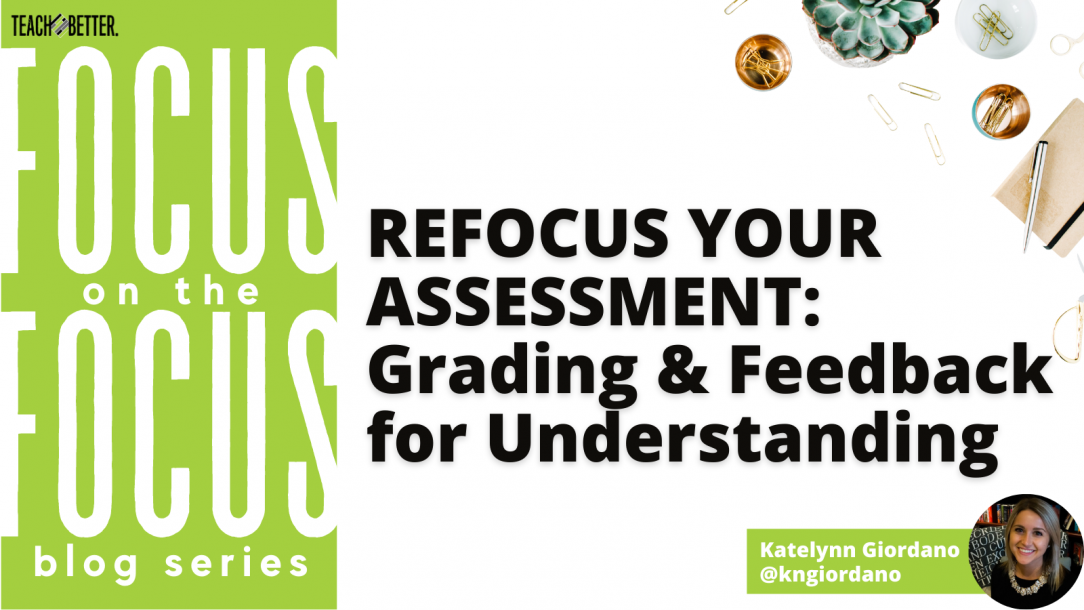TL;DR:
- It is time to refocus your assessment and consider grading and feedback for understanding.
- Make sure students know what the learning goal is and what they are working toward.
- Ensure feedback is specific, useful, and given in a timely manner.
- Consider the following feedback structure: Where are you in your proficiency? Why are you there? What are your next steps?
Refocus Your Assessment: Grading and Feedback for Understanding
Our classrooms, our profession, and our world have been absolutely rocked. This isn’t news to you; you’ve been living this reality for over a year now. And if you’re anything like me, it has challenged you, overwhelmed you, and changed you in countless ways.
And while this year has upended what we thought we knew, it’s also provided us an opportunity. One that can only come, as a phoenix does from the ashes, from great upheaval and setting fire to what we’ve always done.
Grading and feedback is an area that we’ve had to completely refigure. A year ago, school districts across the country were asked to halt all grading and shift their assessment practices completely away from a system that enforces compliance, toward one that is feedback-based. Many educators were largely unprepared for this shift in thinking, let alone practice. And while this is not the way I would have hoped that we started this conversation or change, I can’t say I’m upset that it happened.
Because grading needs to change. Feedback and assessment must evolve. And that change is no longer optional.
There are so many pieces to consider as you make a change toward feedback and grading for understanding. Whether it be student motivation, communication with families, useful feedback that is actually taken…there are innumerable questions that we need to answer. While I could never answer all of them (at least not in one blog post), I can tackle some of the ones that come up often.
Because grading needs to change. Feedback and assessment must evolve. And that change is no longer optional. Click To TweetHow will I keep students motivated to do the work if it isn’t worth anything?
This question gets right to the heart of the issue: what is the point if there are no points?
My response is typically to question the question and poke the bear a little here. If the work isn’t ‘worth anything,’ why assign it in the first place? If the only value found in an assignment is the number of points that can be earned, is it truly something that provides valuable growth, practice, or learning for students?
The thinking shift here must be focused on the value of the work being done. Rather than thinking of them as assignments, think of them as learning experiences. What is the skill students are engaging in? Does the experience you are providing give them an opportunity to practice or demonstrate their progress at that skill? Do they know what they are working toward and what the learning goal is?
These questions and considerations can help shift the focus away from points and toward learning. When they are communicated explicitly to students, the value in doing the work becomes apparent.
Giving this much feedback is impossible. How can I possibly give specific, useful feedback in a timely manner?
This is where we can dig into some tips and tricks to help you manage your time and your assessment more effectively.
Start by identifying what skills you are assessing in a given unit, grading period, or whatever time frame you use. Be clear and concise in choosing those skills. They may not be the only things you teach, but they should be the only things you assess.
After you’ve done that first step, create a proficiency scale for yourself and your students. It can be as simple as “Yes, they’ve got it” or “No, they don’t have it yet,” or you can develop one with more nuance to it. I’ve used several different ones, and the best one is the one that works for you and your students.
Then, create qualifiers. What does it look like to demonstrate proficiency at that skill? AKA, how will you know they’ve got it? This can look like a rubric, a checklist, anything really. Again, as long as it works for you and your students, it will work.
Once you have this all developed, you can give feedback on any skill you assess quickly and efficiently. If the student ‘got it,’ your feedback is right there. They got it, and this is how you know. If the student doesn’t have it yet, you have already identified why and can easily communicate that to them.
How do I use feedback to help students grow?
Using your new and improved ‘feedback for understanding’ system, you can make sure the feedback you’re providing is focused on helping students progress.
It may seem like this will decrease your efficiency, but it doesn’t have to. The answer is simple. Find a feedback structure that is consistent and use it. No matter what.
My feedback structure looks like this:
- Where are you in your proficiency? I use a skill rubric for this, and it’s as simple as identifying whether they have it or don’t.
- Why are you there? This tells how I know which mastery level or area of proficiency they have reached.
- What are your next steps? This is where the growth comes in. I give 1-2 suggestions or action steps that will take their work to the next level of understanding. This is direct, targeted feedback that tells exactly what must be done.
This structure works well for me and my students because I have communicated it with them and because I allow reassessments. Students have an incentive to actually use my feedback to reassess a skill, so they do it. They also know what kind of feedback I will give, so they know what to expect each and every time.
[scroll down to keep reading]
Do I have to do this on every single assignment?
Stop grading everything. Refocus your assessment and ensure that what you are giving students is worthwhile. If it isn’t, don’t assign it. If it is, you should be giving feedback on it because it is a valuable opportunity for growth.
Work does not need to be assigned every single day, nor does every single assignment require written feedback. Utilize verbal feedback, meaningful student conferencing, and tech tools to give oral feedback on work that has been turned in (Google add-ons has so many of these).
We have such a unique opportunity to rethink the way we do assessment and grading, especially because our entire education system has been turned on its head.
Don’t take this chance lightly. Use it to make some realistic, necessary changes so your grading and assessment align with your values and encourage student growth. Use this time to grade better.
About Katelynn Giordano
Katelynn Giordano is a Middle Level Language Arts Educator in Illinois and the Director of Curriculum & Instruction for the Teach Better Team. She is a dynamic educator who is passionate about student voice and empowerment, promoting equity, and valuing teachers as professionals.
In 2019, Katelynn presented information on action research in the classroom with a team at the National Council of Teachers of English Convention in Baltimore.
You can check out more of Katelynn’s work & her writing on her website KatelynnGiordano.com or her blog Curriculum Coffee.
Katelynn is also a member of the Teach Better Speakers Network.



